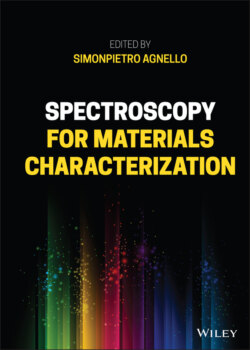Читать книгу Spectroscopy for Materials Characterization - Группа авторов - Страница 24
1.3.3 Dispersion Elements: Gratings and Resolution Power
ОглавлениеIn typical spectroscopy experiments, it is necessary to select the energy, or wavelength, of the radiation that impinges on the sample under study, to determine its effect, or to analyze the radiation emitted by the sample. For example, in the case of a continuous light source, it is mandatory to select those wavelengths that could induce an absorption effect; otherwise, it would not be possible to understand the microscopic features giving the process and to reconstruct the fundamental information of the energy levels’ distribution. The typical systems used to disperse and select the wavelength of a source comprise a prism, a grating, or an interferometer [2, 7, 22]. Each of these systems enables to select a wavelength and an interval around it, called bandwidth. The choice of the specific dispersing tool depends on the kind of experiment and the spectral resolution needed, that means the bandwidth of the selected radiation, or the light throughput. For the UV‐Vis spectroscopy, the most used system is the grating with the monochromator [2, 10]. The latter is an optical system with a couple of slits to let the light enter and exit it, some mirrors to drive the light inside it, and one or more gratings to spatially separate the wavelengths and select them. The core part of this system is the grating that is constituted by a series of N slits of equal width, parallel to each other and with distance d [1]. It is shown that for a parallel light beam impinging perpendicularly to a transmission planar grating, there is a maximum of intensity of transmitted light for those rays of wavelength λ deviated with respect to the normal to the grating plane by the angle θ
(1.114)
where m is an integer, giving the order of interference [1]. The presence of more slits implies that between two adjacent maxima, given by different values of m, there are minima of intensity for
(1.115)
These equations can be used to show that the angular distance between the maxima of interference of two wavelengths at distance Δλ is given by
(1.116)
giving the angular dispersion of a grating. This depends on the distance between the slits, usually reported as (number of lines)/mm, and it increases on increasing the lines/mm constituting the grating (lower value of d) and on increasing the order m of interference. If a monochromator of focal length f is considered [2, 22], the linear dispersion is obtained
(1.117)
yielding the spatial distance Δx, known as linear distance, on a planar screen of the interference maxima of two wavelengths separated by Δλ, and showing that this distance increases on increasing the focal length of the monochromator. Finally, in order to be able to separate the interference maxima of two adjacent wavelengths, the condition usually applied is that the minimum intensity of one wavelength coincides with the maximum intensity of the other. This condition gives the resolving power of a grating:
(1.118)
this is the minimum difference of wavelengths that a grating with N lines can resolve at the interference order m. This feature depends on the number N of slits illuminated and does not depend on their relative distance d. All of the reported features are fundamental for the good choice of a grating to be used in a monochromator.
Finally, in a plane reflection grating, it is usual to give a specific shape profile to the reflecting lines [22]. In this case, it is shown that a plane wave, impinging with the angle I with respect to the normal to the grating plane, is reflected at the angle D with respect to the same normal direction according to the equation [22]
(1.119)
where I and D have the same sign when referred to the same side with respect to the normal to the grating plane. It is found that for m = 0, for any λ, Eq. (1.119) is verified for I = −D, that is total reflection condition, the impinging and the reflected beam are symmetric with respect to the normal to the grating plane. This is known as zero order of the gratings and enables to determine a reference position inside the monochromator, the one that gives the absolute maximum of reflected light because all the wavelengths superimpose. Moving the grating with respect to this position, the angles can be measured and the reflected wavelength satisfying Eq. (1.119) can be determined. This procedure is usually applied in the spectroscopy instrumentations to measure the output wavelength from the monochromator. Finally, this kind of reflecting grating is characterized by a wavelength, or equivalently an angle, of maximum efficiency of reflection with dispersion (not the zero order), called blaze wavelength, and the efficiency of dispersion is near the intensity maximum for typically 100 nm around this wavelength [22].
